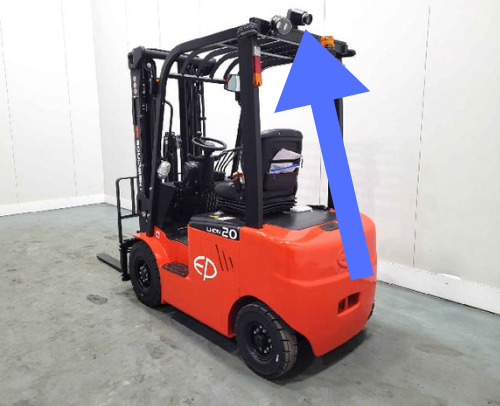Blog
Understanding the blue light in a forklift

Understanding the Blue Light on a Forklift: A Crucial Safety Feature for Operators and Traders
Forklifts are essential tools in warehouses, factories, and construction sites. However, there are risks associated with using them, just like with other strong apparatus. The blue light or spotlight on a forklift is one of the most important safety elements that has become more and more popular in recent times. By realising the significance of this signal, traders and forklift operators alike may greatly increase workplace safety and compliance.
What is the Blue Light on a Forklift For?
A forklift's blue light is an essential safety component meant to avert mishaps, not just an aesthetic addition. Basically, depending on where it is placed, the blue light produces a bright blue spot on the ground several feet in front of or behind the forklift. This light warns nearby workers and pedestrians of the impending forklift by acting as an early warning system.
The blue light becomes an essential visual cue in busy areas where other machines or activities may overpower the sound of the forklift. This is especially crucial in crowded loading docks and warehouses where vision can be poor and mishaps can occur at any time. The blue light reduces the risk of collisions and injuries by alerting workers in advance of an approaching forklift.
The Legalities and Regulations Surrounding Forklift Blue Lights
Changes to safety standards and laws have also resulted from the installation of blue lights on forklifts. Many safety authorities and organisations strongly urge the use of blue spotlights on forklifts as a best practice, even though they are not yet required by law in every region.
For traders, understanding these regulations is crucial when buying or selling forklifts. Ensuring that the equipment you trade complies with the latest safety standards can make your products more appealing to buyers who prioritize workplace safety.
How to Check the Function of the Blue Light on a Forklift
Maintaining the functionality of the blue light is as important as installing it. Here's a simple guide on how to ensure your forklift’s blue light is working correctly:
- Regular Inspection: Incorporate the blue light into your regular forklift inspection routine. Check for any visible damage to the light or its mounting. Ensure that the light is securely attached and not wobbling, as this could affect its effectiveness.
- Test the Light: Turn on the forklift and observe the blue spot projected on the floor. Ensure it is bright and clearly visible from a distance. If the light appears dim or flickers, it may need to be replaced or repaired.
- Cleanliness: Dust, grime, and other debris can accumulate on the light lens, diminishing its brightness and effectiveness. Regularly clean the lens with a soft cloth and a mild cleaner to maintain optimal visibility.
- Positioning: Ensure the light is positioned correctly. The blue spot should be projected a few feet ahead of or behind the forklift. If the spot is too close to the forklift, it won’t provide adequate warning time for pedestrians. If it's too far, it might be less noticeable.
- Battery Check: For forklifts that rely on battery power, make sure that the battery is functioning correctly. A weak battery can reduce the light’s intensity, making it less effective.

Minimum Working Standards for the Blue Light
To ensure maximum safety, the blue light on a forklift should meet certain minimum standards:
- Visibility: The blue spot should be clearly visible from a distance of at least 10-15 feet. This ensures that workers have enough time to react to the approaching forklift.
- Brightness: The light should be bright enough to stand out in various lighting conditions, including brightly lit warehouses and outdoor settings during daylight.
- Durability: The blue light should be robust and capable of withstanding the vibrations and movements typical in a forklift's daily operations.
- Compliance: While not universally mandated, adhering to the highest safety standards, such as those recommended by OSHA or EU directives, can provide peace of mind and demonstrate a commitment to workplace safety.
Conclusion
Operators and dealers alike must comprehend the function and significance of the blue light on a forklift. By giving pedestrians and other workers a visual warning, this simple but effective element greatly improves safety by reducing the likelihood of accidents and injuries. You can help create a safer workplace and guarantee that your forklifts continue to adhere to safety guidelines by keeping up with the regulations, routinely testing the equipment, and making sure the light satisfies the necessary requirements.
For those in the market for forklifts, either as a buyer or seller, considering the presence and quality of the blue light can be a decisive factor, not just for safety but also for compliance with industry standards. By prioritizing this feature, you're not only protecting lives but also adding value to your equipment.
Subscribe
Keep up to date with PHL and all things forklift machinery.